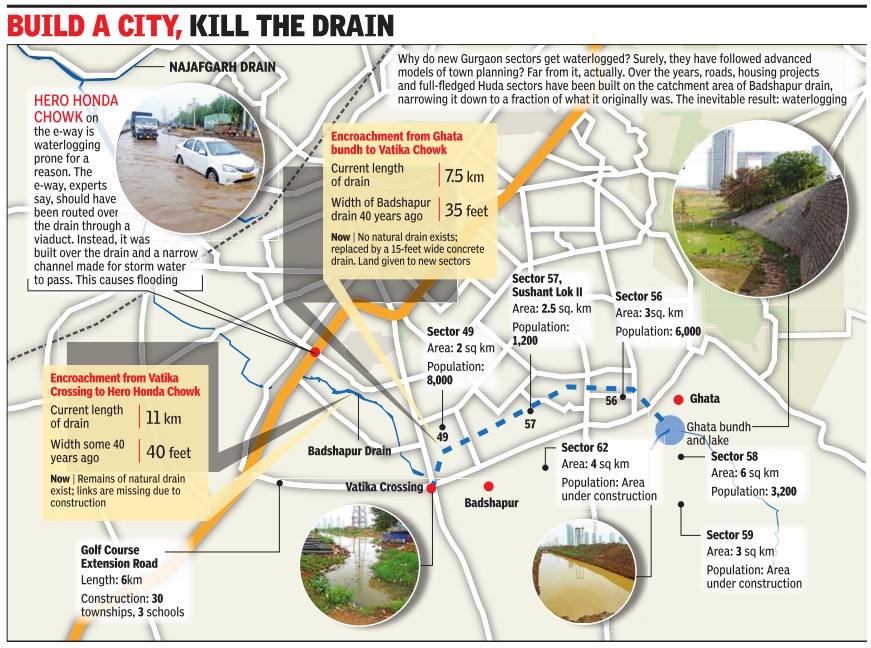Gurgaon: Civic issues
This is a collection of articles archived for the excellence of their content. |
Contents |
Air pollution
2017, Nov: Cyber City worst, Gwalpahari best
Shilpy Arora, Cyber City junction Ggn’s most polluted area, January 5, 2018: The Times of India
The air at the traffic junction at Cyber City was found to be the city’s most polluted, in a survey conducted by Teri (The Energy and Resources Institute) during the last week of November 2017. The Gwalpahari junction was the least polluted.
The survey was conducted at the request of the Gwalpahari-based IT-ITES SEZ, ASF Insignia, at three areas — Cyber City, Gwalpahari and Iffco Chowk, over four days between November 22 and November 30 (24 hours, 2pm-2pm each day). In the end, the average concentration of PM2.5 at the Cyber City junction was reported to be 348 micrograms per cubic metre (µg/m3). At Iffco Chowk, it was 308µg/m3 and near the ASF Insignia office at Gwalpahari, it was 174µg/m3. Iffco Chowk, however, led in the average PM10 levels, at 651µg/m3. At all locations, other pollutants such as carbon monoxide, nitrogen dioxide and sulphur dioxide were found within permissible limits.
The PM10 reading across various locations ranged between 232µg/m3 and 671µg/m3, while the corresponding PM2.5 levels varied between 136µg/m3 and 491µg/m3. The results revealed that levels of particulate matter (both PM10 and PM2.5) at all three locations throughout the monitored period were above permissible limits (24-hour industrial/residential standard), of 100µg/m3 for PM10 and 60µg/ m3 for PM2.5.
According to Ved Prakash, research analyst at Teri, methods followed for measuring pollutants were in accordance with guidelines. “Pollutants were measured as per guidelines laid down by Bureau of Indian Standards and Central Pollution Control Board. While fine particulate samplers were used to measure PM levels, nitrogen dioxide and sulphur dioxide, portable hand-held Q-track monitors were used to measure carbon monoxide,” he said.
Experts blamed traffic congestion for the high PM2.5 at Cyber City. “The Cyber City junction witnesses the maximum jams, particularly during peak hours,” said Niranjan Raje, former member of Environment Pollution Control Authority.
Bus service
2018: inauguration
The city’s prolonged wait for a bus service ended when Gurugaman — the official name given to the service — was flagged off with a fleet of 25 low-floor, non-AC passenger coaches. Initially, the low-floor buses will ply from Sector 10 bus terminal to Huda City Centre metro station, which is route number 212. By March 2019, as many as 200 more buses will be inducted in the city, according to sources.
The 12-km route in the first phase covers major junctions, including Basai Chowk, Atul Kataria Chowk, IFFCO Chowk, Huda City Centre, Subhash Chowk, Atul Kataria Chowk, Hero Honda Chowk and Huda City Centre, and will conclude at Sector 10 bus terminal.
“A number of bus stops have been built at strategic points to cater to commuters, and new routes will be introduced by March 2019,” said CM Manohar Lal Khattar after the inauguration of the service on Sunday morning. He also rode the bus from Sector 10 bus depot till Huda City Centre metro station.
“Gurgaon needed a smart public transport system, and the government is hopeful that the city bus service will cater to that,” said Khattar.
Urbanisation issues
CSE study, 2017
Ggn turning living hell: Study, June 2, 2017: The Times of India
Gurgaon is witnessing “explosive urbanisation“ and its critical resources like water, the environment, land and biodiversity are being stretched to the limit to accommodate this growth, raising the possibility of the city turning into a “living hell“ if a sustainable development model is not followed, a study has warned.
The study also notes that pollution has increased manifold in the city over the years, often to levels that are above even Delhi's, and a major contributor to that is this piece of sta tistic -the number of cars per 1,000 people is four times higher in Gurgaon than in Delhi.Worse, a majority of the city's energy need comes from diesel.
“Gurgaon has 10,000 diesel gensets. One genset is equal to the emission of four heavy commercial vehicles. There is a need to replace diesel gensets with solar power generation that can be used during the power outages,“ said Anumita Roychowdhury of the Centre for Science and Environment (CSE), who has authored `Gu rugram: A Framework for Sustainable Development', the book based on the study conducted by CSE and Gurgaon First, an NGO.
The book is about challenges staring at Gurgaon and possible solutions, and was released officially on Thursday by the MCG, under whose aegis the study was conducted. “This kind of growth has made enormous demands on resources, including water, energy , land, mobility , and is generating mountains of waste. If not addressed, this can turn Gurugram into a living hell,“ the book observes.
Waterlogging
2016

See graphic:
Waterlogging in Gurgaon, August 2016